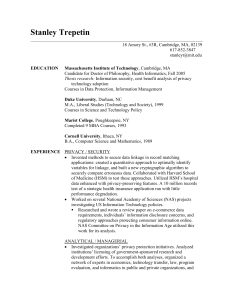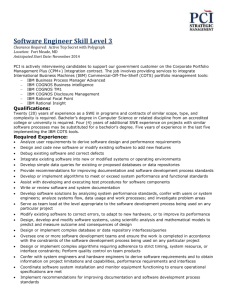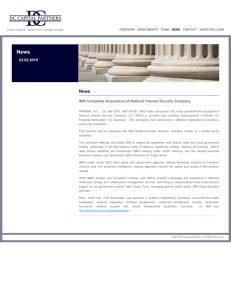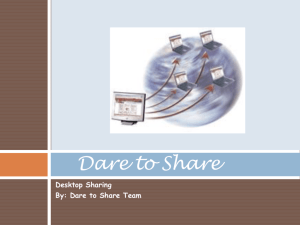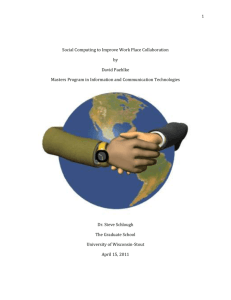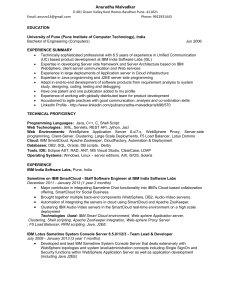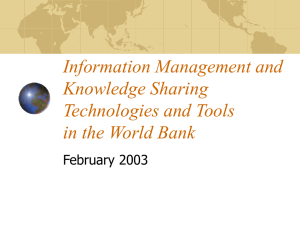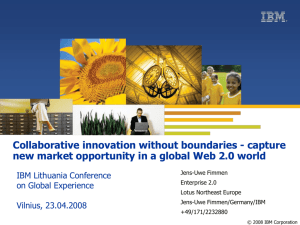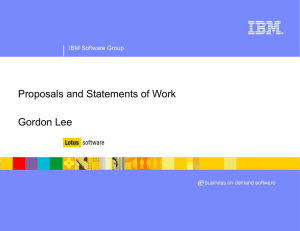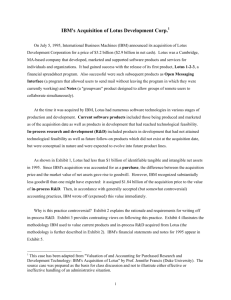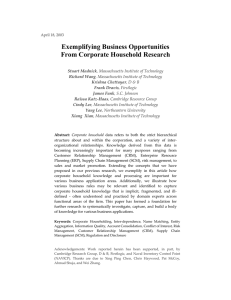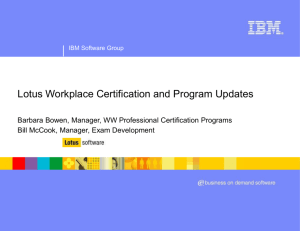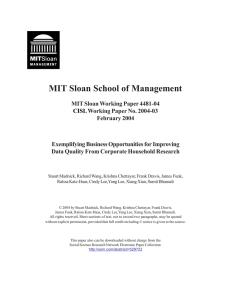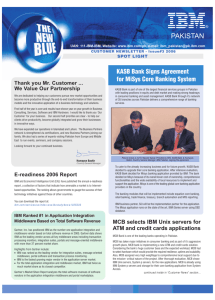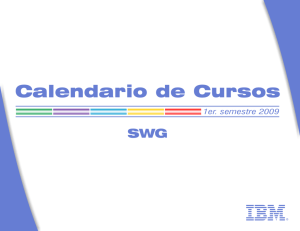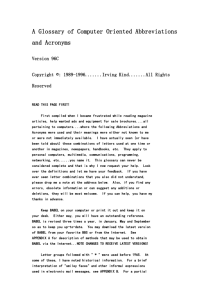Next Generation Activity-Centric Computing
advertisement
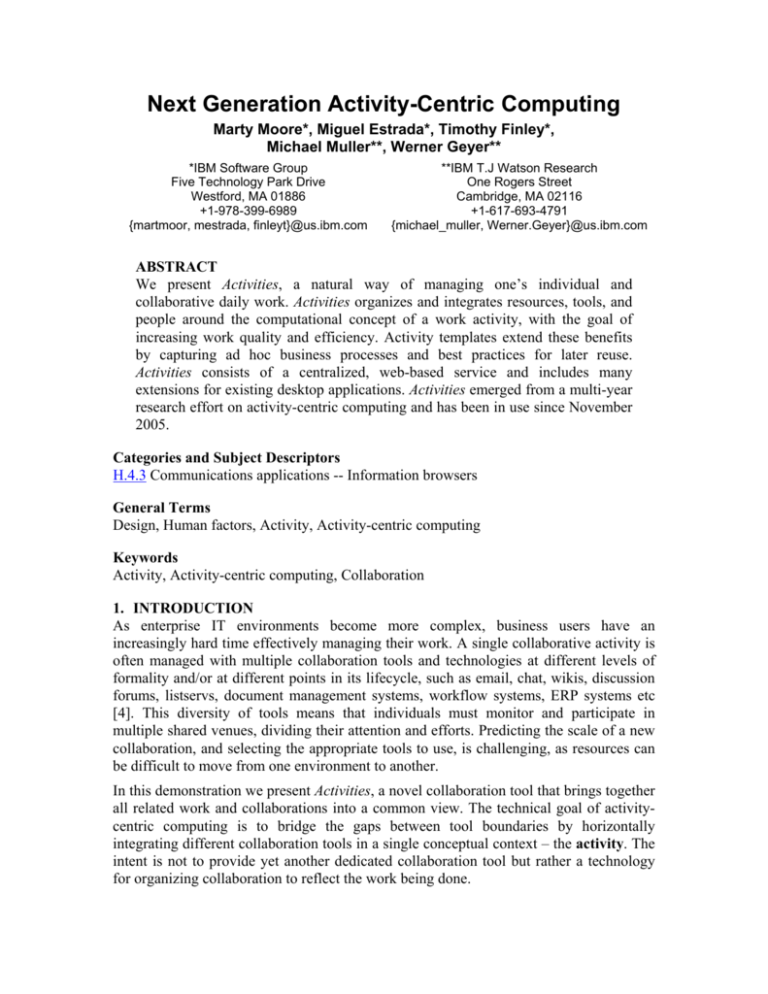
Next Generation Activity-Centric Computing
Marty Moore*, Miguel Estrada*, Timothy Finley*,
Michael Muller**, Werner Geyer**
*IBM Software Group
Five Technology Park Drive
Westford, MA 01886
+1-978-399-6989
{martmoor, mestrada, finleyt}@us.ibm.com
**IBM T.J Watson Research
One Rogers Street
Cambridge, MA 02116
+1-617-693-4791
{michael_muller, Werner.Geyer}@us.ibm.com
ABSTRACT
We present Activities, a natural way of managing one’s individual and
collaborative daily work. Activities organizes and integrates resources, tools, and
people around the computational concept of a work activity, with the goal of
increasing work quality and efficiency. Activity templates extend these benefits
by capturing ad hoc business processes and best practices for later reuse.
Activities consists of a centralized, web-based service and includes many
extensions for existing desktop applications. Activities emerged from a multi-year
research effort on activity-centric computing and has been in use since November
2005.
Categories and Subject Descriptors
H.4.3 Communications applications -- Information browsers
General Terms
Design, Human factors, Activity, Activity-centric computing
Keywords
Activity, Activity-centric computing, Collaboration
1. INTRODUCTION
As enterprise IT environments become more complex, business users have an
increasingly hard time effectively managing their work. A single collaborative activity is
often managed with multiple collaboration tools and technologies at different levels of
formality and/or at different points in its lifecycle, such as email, chat, wikis, discussion
forums, listservs, document management systems, workflow systems, ERP systems etc
[4]. This diversity of tools means that individuals must monitor and participate in
multiple shared venues, dividing their attention and efforts. Predicting the scale of a new
collaboration, and selecting the appropriate tools to use, is challenging, as resources can
be difficult to move from one environment to another.
In this demonstration we present Activities, a novel collaboration tool that brings together
all related work and collaborations into a common view. The technical goal of activitycentric computing is to bridge the gaps between tool boundaries by horizontally
integrating different collaboration tools in a single conceptual context – the activity. The
intent is not to provide yet another dedicated collaboration tool but rather a technology
for organizing collaboration to reflect the work being done.
Figure 1. Web-based activity dashboard.
The basic idea behind Activities is simple: Reorganize collaboration to reflect the work
being done, rather than the technologies that support the work. An activity can be
defined as a logical unit of work that incorporates all the tools, people, and resources
needed to get the job done [5]; related concepts include Working Spheres [2] and Thrasks
[1]. Examples of activities are: preparing an executive meeting, planning a conference,
closing a sale, or writing or responding to a Request for Proposals.
This project is a direct result of years of research into activity centric collaboration,
including the research on Activity Explorer [5], the research work done in Unified
Activity Management [4], and the Dogear social bookmarking system [3].
2. ACTIVITY SYSTEM
The design of Activities was driven by the goal of organizing work into shared or private
activities. In this system an “activity” consists of a set of related, shared objects
representing a task or project. The set of related objects is structured as a hierarchical
thread called an “activity outline”, representing the context of the task at hand. The
activity outline is similar to an activity thread [5], with more explicit structure than a
working sphere [2], and greater diversity of resources than a thrask [1]. Users add items
to activities by posting either a response to an existing object or a new resource addition
directly to the activity. Activities initially supports sharing of six types of objects:
message, chat transcript, file, tasks, web links, and email. Complex tasks can be
structured through sub-activities. The system is extensible, i.e. new object types can be
added to customize the system to particular application scenarios.
Activities are shared per default. There are three simple access roles: owner, author, and
reader. In addition, Activities provides fine-grained privacy options for each object.
Activities also supports more structured collaborations in the form of activity templates
[4]. Any activity can be copied into a template that can be used to create a new activity or
sub-activity – for instance, if a person reviews journal submissions on a regular basis,
they can create an activity template that includes a checklist and links to resources that
are needed to perform the review.
Activities and objects within them can have simple metadata associated with them:
description, due date, and tags. Keyword tagging allows users to find related resources in
a single activity or across activities. Users can also search for terms within a specific
activity, or across all their activities.
Figure 2. Activities embedded in the IBM
Lotus Sametime Instant Messaging client
There are several ways users can manage their list of activities. Users can see a list of
their activities by visiting a web-based activity dashboard (see Figure 1), or by
subscribing to an RSS feed of their activities. Additionally, users may access their
activities through a number of desktop-based extensions such as the IBM Lotus
Sametime IM client (see Figure 2), Mozilla Firefox, or Microsoft Office. A user’s
activity list can be sorted by last modified date, due date, participants, or tag.
Each activity has a web page associated with it (see Figure 3) so that users can see recent
entries posted to the activity, navigate the activity outline, see all the entries in the
activity organized by type, and see the history of the activity. Similar to Activity Explorer
[5], the activity outline is automatically structured based on the response hierarchy in an
activity, but it can also be reorganized post-hoc if a user wants to create their own
structure within the activity.
Users can access and post objects to activities either from the activity web page or from
their usual working contexts: mail, office editor, web browser, instant messaging client,
and line-of business tools such as a Lotus Notes database.
3. USAGE DATA
The Activities system has been in use internally since November 2005, and was broadly
deployed within IBM in May of 2006. We have been gathering usage statistics during
both of these periods. To date there are 2,682 registered users, with 2,327 activities and a
Figure 3. Activity web page with activity
total of 15,506 objects in those activities. The adoption rate of the service is constantly
growing. We have begun analyzing the data and will report on these results in a separate
publication.
4. CONCLUSION
This Activities system is the first step in a long-term development path toward building
an activities service which is open, extensible, and easily integrated into the particular
toolset of a user or corporation. Further improvements will be made in personal activity
management, with particular emphasis on interruption management, task prioritization
and deadline management, and tighter integrations with a user’s mail, calendar, and
contacts tools, including lessons learned from [1,2,4]. Ultimately, Activities will support
extranet collaboration, allowing individuals or businesses to collaborate in activities
across organizational boundaries.
5. ACKNOWLEDGMENTS
We thank the Collaborative User Experience group of IBM Research and the Activities
team at IBM Software Group.
6. REFERENCES
Bellotti, V., Ducheneaut, N., Howard, M., and Smith, I. “Taking email to task: The
design and evaluation of a task management centered email tool,” Proc CHI 2003.
[2] González, V.M., Mark, G., “’Constant constant multitasking craziness’: Managing
multiple working spheres,” Proc. CHI 2004.
[3] D.R. Millen, J. Feinberg, B. Kerr, “Dogear: Social Bookmarking in the Enterprise,”
Proc CHI 2006.
[4] T. P. Moran,.A. Cozzi, S.P. Farrell, “Unified activity management: supporting people
in e-business,” Commun. ACM 48(12) (Dec. 2005), 67-70.
[5] M. Muller, W. Geyer, B. Brownholtz, E. Wilcox, D. R. Millen, “One Hundred Days
in an Activity-Centric Collaboration Environment based on Shared Objects,” Proc.
CHI 2004.
[1]





